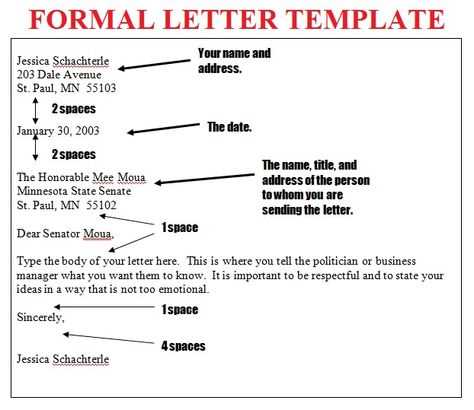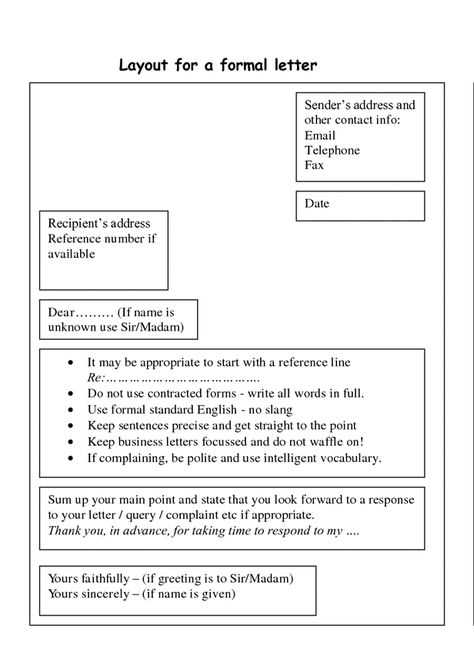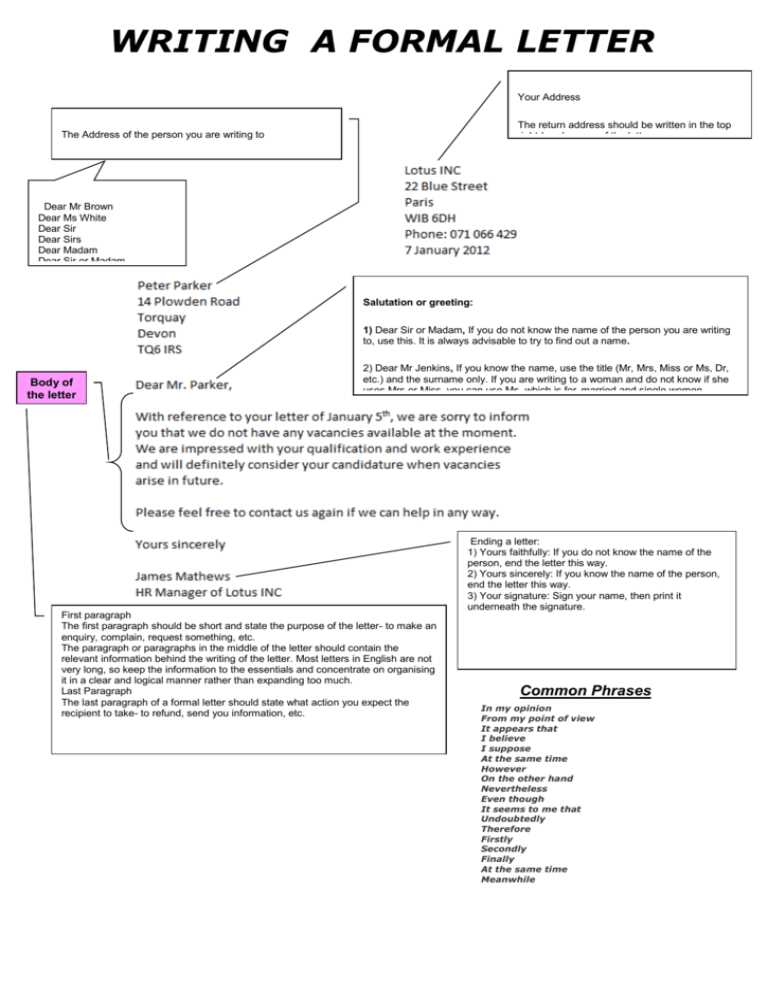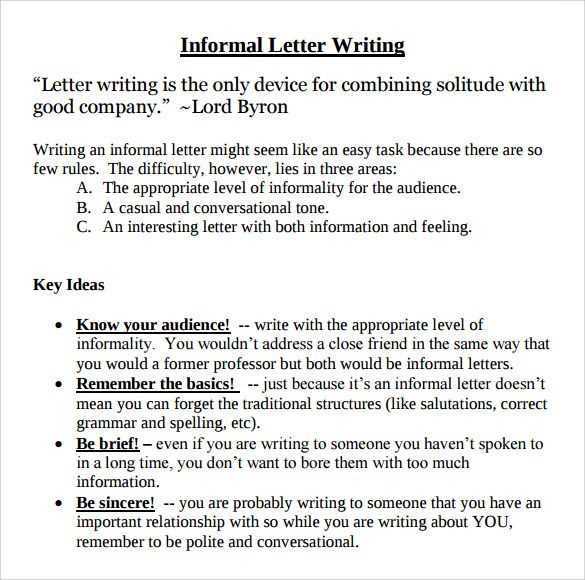How to write a formal letter template

Begin with your sender’s information at the top of the page. Include your full name, address, phone number, and email. If you’re using a company letterhead, this section is usually pre-filled. Next, add the date beneath your contact details.
On the left side, below the date, provide the recipient’s information. List their name, title, company name (if applicable), and address. Make sure the recipient’s name and title are accurate, as this sets the tone of your letter.
When addressing the recipient, use formal language. “Dear [Title] [Last Name]” is standard for most formal letters. If you’re unsure about the title, “Dear Sir/Madam” works, but try to find the name to make it more personal.
For the body of the letter, keep your language clear and to the point. Start with a concise introduction outlining your purpose. Use the middle paragraphs to expand on the details, avoiding unnecessary information. End the letter with a strong closing statement, such as “I look forward to hearing from you” or “Thank you for your time and consideration.”
Close with a formal sign-off like Sincerely, followed by your signature and printed name. If you’re sending a digital copy, including a scanned signature adds a personal touch.
How to Write a Formal Letter Template
Begin with your contact information at the top of the page, including your name, address, phone number, and email address. Skip a line after your information before adding the date. Next, include the recipient’s contact details, followed by a formal salutation such as “Dear Mr./Ms. [Last Name],” or “To Whom It May Concern,” if the specific recipient is unknown.
The opening paragraph should clearly state the purpose of the letter. Avoid unnecessary pleasantries or filler. Be direct and concise. For example: “I am writing to inquire about the status of my application for the position of [Job Title] at [Company Name].”
The body of the letter should elaborate on the purpose. Use clear, simple sentences and structure the letter logically. If making a request, be specific about what you need, and provide any relevant background information that supports your request.
In the closing paragraph, express appreciation for the recipient’s time or attention, and indicate your willingness to provide further information if necessary. End the letter with a polite closing such as “Sincerely” or “Best regards,” followed by your name and signature (if sending a physical letter).
Proofread the letter carefully for any mistakes in grammar, spelling, or punctuation. Ensure that the tone remains polite and formal throughout. A formal letter should be concise, respectful, and professional in both language and structure.
Choosing the Correct Salutation for Your Formal Letter
The salutation sets the tone of your letter, so it’s vital to address the recipient appropriately. It’s best to use a formal greeting unless you have a personal relationship with the recipient.
If you know the recipient’s name, use “Dear Mr. [Last Name]” or “Dear Ms. [Last Name]”. If the person prefers a different title, such as Dr., use that instead. When addressing a woman, opt for “Ms.” unless you know she prefers “Mrs.” or “Miss”. If the recipient’s gender is unclear or if you are unsure, “Dear [Full Name]” can be a neutral option.
For situations where you don’t know the recipient’s name, use “Dear Sir or Madam” or “To Whom It May Concern.” These are considered respectful and widely accepted in formal contexts. Avoid overly generic or casual greetings like “Hello” or “Hi”.
If you are addressing a group or organization, use “Dear [Organization Name] Team” or “Dear Members of the [Department Name]”. In formal correspondence with multiple recipients, it’s important to respect hierarchy, so address the highest-ranking person first if possible.
Here’s a summary of formal salutations based on different situations:
| Situation | Salutation |
|---|---|
| Known recipient (gender-specific) | Dear Mr. [Last Name] / Dear Ms. [Last Name] |
| Known recipient (gender-neutral) | Dear [Full Name] |
| Unknown recipient | Dear Sir or Madam / To Whom It May Concern |
| Addressing a group | Dear [Organization Name] Team / Dear Members of [Department Name] |
Selecting the right salutation reflects your professionalism and helps set a respectful tone for the rest of your letter.
Writing the Main Body: Presenting Your Message Clearly
Focus on delivering your message directly. Each paragraph should address a specific point. Avoid unnecessary details that don’t contribute to your main argument or request. Use clear and simple language to convey your ideas without ambiguity.
Be Concise and Straightforward

Avoid wordiness. Get straight to the point in each section, and make sure each sentence serves a clear purpose. Trim any excess phrases or filler words. This will keep the reader’s attention and make your letter more impactful.
Organize Your Ideas Logically
- Start with your primary message or request, then explain it in detail. Make sure each point follows logically from the previous one.
- If you need to provide background information, keep it brief and relevant. Focus on the facts that help clarify your request or argument.
- Conclude by restating your message clearly, reinforcing the action or response you expect.
Each paragraph should flow naturally to the next. Break up complex ideas into manageable chunks to avoid overwhelming the reader.
Crafting a Polite and Professional Closing

End your letter with a closing that reflects respect and professionalism. A well-chosen closing phrase can leave a positive final impression. Avoid overused phrases like “Yours sincerely” unless it aligns with your specific context. Tailor your closing to the tone and purpose of your letter, while remaining courteous.
Choose the Right Phrase
For formal business letters, phrases like “Best regards,” “Kind regards,” or “Sincerely” are appropriate. If you’re writing to someone with whom you’ve established a more familiar relationship, “Best wishes” or “Warm regards” may be suitable. Avoid overly casual or overly familiar phrases unless the situation specifically calls for it.
Close With Your Full Name
End the letter by providing your full name, especially in professional contexts where clarity is important. This ensures the recipient knows exactly who is reaching out. If applicable, include your title or role beneath your name to add formality.
Formatting the Letter for Maximum Clarity
Use clear headings and subheadings to separate sections of your letter. This helps the reader quickly find relevant information. Ensure each paragraph is concise, focusing on one idea at a time. Avoid long sentences that may confuse the reader. Break up complex thoughts into simpler statements.
Choose a readable font and size, such as Times New Roman, 12-point, for easy readability. Stick to a standard letter format, using proper margins (1 inch on all sides). This ensures that the letter looks professional and neat.
Align your text to the left, as it is the standard for formal letters. This keeps your content organized and helps the reader easily follow along. Double-space between paragraphs to provide breathing room and prevent the text from feeling cramped.
Use bullet points or numbered lists when outlining multiple items. This makes the information stand out and easier to scan. Avoid large blocks of text that may overwhelm the reader.
Check for consistency in formatting throughout the letter. If you use bold for headings, apply it to all of them. Maintain uniform font sizes and spacing to enhance the letter’s professional appearance.
Before sending the letter, proofread it for clarity and formatting errors. A clean, well-formatted letter conveys professionalism and increases the likelihood of your message being understood.
Proofreading: Ensuring Accuracy and Correctness
Check your letter multiple times to catch errors that may affect its clarity. Focus on spelling, punctuation, and grammar, as these details contribute significantly to a letter’s professionalism. Read it aloud to identify awkward phrasing or misplaced commas that may disrupt the flow.
Spelling and Grammar Check
Always verify the spelling of names, places, and specific terms. A simple mistake here can lead to confusion or misinterpretation. Use grammar-checking tools to spot common issues like subject-verb agreement, incorrect tenses, or missing articles. However, never rely solely on software–manual checks are necessary to catch nuanced mistakes.
Consistency and Clarity

Ensure consistency in formatting, such as date formats, punctuation usage, and titles. A letter with mixed styles may confuse the reader or appear sloppy. Review the tone to ensure it aligns with the purpose of your letter–whether formal, neutral, or polite–and make sure each sentence contributes to the overall message without unnecessary complexity.